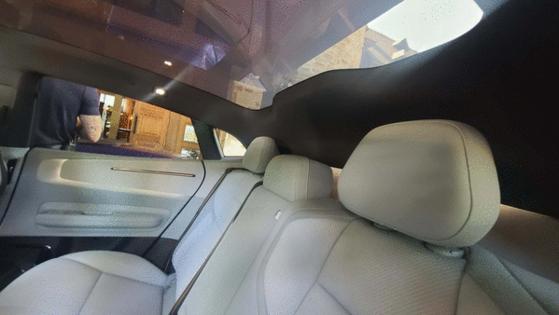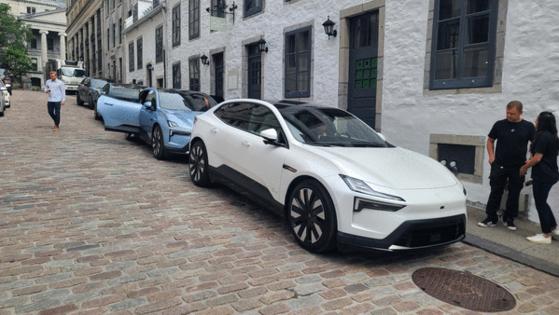How Chinese-owned, Volvo-inspired, foreign-made Polestar startup is navigating the EV market, tariffs
Published in Automotive News
MONTREAL — Volvo Cars created its performance-focused Polestar electric vehicle brand to go head-to-head against Tesla. A subsidiary of Zhejiang Geely Holding Group, it is also the first Chinese-owned EV brand for sale in the United States and sits at the intersection of swift industry currents, including import tariffs, electrification and government subsidies.
Made in South Korea and coming to the North American market this fall, the Swedish-designed, compact Polestar 4 SUV is the brand’s most important product in the industry’s biggest segment, taking on the best-selling Tesla Model Y.
The 4, built on the same platform as China’s Zeekr 001, is at the heart of a model lineup that includes a Polestar 2 (Model 3 sedan competitor), Polestar 3 (midsize SUV), Polestar 7 (due in 2026) and Polestar 1 sports coupe. When it goes on sale this fall, Polestar 4 will face ill feelings toward China post-COVID, the stagnation of the EV market and 25% import tariffs at a time when Canadian and U.S. EV government subsidies are going away.
Nevertheless, Polestar says it is full speed ahead for the North American luxury market.
“Since Polestar was created, it was always designed, engineered and managed from Sweden. It was very important that we had independence,” Dean Shaw, Polestar's chief of public relations and communications, said in an interview here. “We have many shareholders (and) a very large shareholder, of course, that's based (in China). We don't see any concerns around this. We've got a lot of independence, we're free to do what we need to do, and we are overseen by regulations in the U.S.”
Owned by Ford Motor Co. from 1999-2010, Volvo was sold to Geely, which today owns about 80% of the company. Polestar earned early notoriety for modifying Volvos as race cars and ultimately evolved to Volvo’s official performance partner (think AMG for Mercedes). Volvo bought Polestar in 2015 and repurposed it as an EV brand in 2017 to attract investment — and engineering learnings — at a time when EV startups were red hot amid soaring Tesla evaluations.
“I don't think people know that Polestar is owned by the Chinese,” said auto analyst Rebecca Lindland, managing director for Allison Worldwide. “I don't think people know Volvo is owned by Geely, either.”
Lindland said that there was a “lot of tension” in Gothenburg (Volvo’s Swedish headquarters) when Geely bought Volvo. “But (the Chinese) have basically taken the Warren Buffett approach: if you're doing things well, I'm going to leave you alone,” she said.
Unlike EV startups Rivian Automotive Inc., Lucid Motors, Fisker Inc., and Bollinger Motors that have struggled to build sustainable capital and manufacturing models, Polestar has access to Geely’s deep capital resources and international manufacturing footprint. Its four EVs have been built in Chengdu, China (Polestar 1 alongside the Zeekr X EV small SUV), Luqiao, China (Polestar 2 alongside the Volvo XC40), Ridgeville, South Carolina (Polestar 3 alongside Volvo S60 sedan, XC60 and EX90 EV SUVs), and Busan, South Korea (Polestar 4 alongside Geely and Renault models).
“We have access to all of the technologies within the broader Geely group — and from a manufacturing perspective as well,” said Shaw, who has had multiple roles with Volvo over four decades in the United States and Europe. “Rather than trying to build our own factory — and the heavy investment needed from that — we can be very nimble. (We) build our cars at other existing factories within the greater infrastructure that gives us a really competitive advantage, I think, against other EV startups.”
Being part of an industrial colossus like Geely is a huge capital benefit (see Hyundai/Kia), said Los Angeles-based analyst Lindland, who was communications chief for EV startup Fisker before it went bankrupt last year. She said it also gives Geely a foothold in the U.S. market by building a subsidiary production here.
Polestar built its brand identity slowly. In 2020, it introduced the six-figure Polestar 1 coupe to signal the brand’s performance intent. That was followed in 2022 by Polestar 2, a fastback competitor to the Tesla Model 3 with similar sleek proportions and power. Polestar has since stopped selling new Polestar 2s in the United States.
Since the introduction of the 2 hatchback in the United States, Polestar has sold 33,262 units here as of July 31, including the introduction of its second U.S. model, the 3 SUV, for 2025. The Polestar 3 starts at $67,500 and has up to 350 miles of range.
Now come Polestar’s core electric SUV products, and none too soon as global Polestar sales slumped in 2024. The compact 4 SUV joins the midsize 3 (the brand names its vehicles, not by size, but in chronological order as to when they are introduced) in the U.S. market. The Polestar 3’s 2,396 unit sales in the United States in the first half of 2025 placed it eighth (of 14) in the luxury midsize EV SUV segment.
Globally, Polestar retail sales grew to 30,319 units in the first half of this year, up 51% year over year. “Volume growth of 38% in the second quarter and 51% in the first half of the year is a clear sign that our retail expansion is delivering and that more customers are choosing Polestar,” said CEO Michael Lohscheller.
Like their 1 and 2 predecessors, the 3 and 4 SUVs are quick and bear simple, Scandinavian designs. The 4 starts at $56,400 and offers up to 300 miles of range.
“What Polestar wanted to do was (take) a slightly different direction, a performance direction,” said Shaw. It enabled “Volvo to stay true to Volvo's heritage. (Polestar) wanted to be the performance electric car brand, and that is very clearly our point of differentiation.”
Analyst Lindland is less convinced a new brand is worth the effort. “You do a lot of marketing, and it's very capital intensive to establish a brand in any market,” she said. “A brand like Volvo has such a clear message of safety, reliability. Polestar should just be an alternative powertrain.”
Polestar reported a first-quarter net loss of $190 million.
The South Carolina plant is an important asset for Polestar as the Trump administration’s tariffs on imported vehicles take hold. The Chinese-assembled Polestar 2 has already been discontinued in part due to a 100% tariff on Chinese-sourced products, and the Polestar 4 faces a 25% tariff coming from South Korea.
“At the moment, the pricing that we’ve launched for Polestar 4 is set up with the current level of tariffs in mind,” Shaw said. The luxury SUV starts at $57,800.
With multiple manufacturing plants around the world feeding 28 markets, Shaw said that Polestar and Volvo are hoping for stability from governments.
“The situation at the moment is probably more complex than ever, but everybody's facing the same situation,” he said “It's a global business. We can't put plants in 28 markets in the world, so we have to distribute that in the smartest way. How do we optimize our manufacturing footprint?”
Shaw said the rich U.S. market — the world’s second-largest after China — has always been a manufacturing focus and Polestar/Volvo are expanding production here just as transplant manufacturers like Toyota Motor Corp., Honda Motor Co., BMW AG, and Mercedes-Benz Group AG did in the 1980s in the face of that era’s tariff threats. Today, foreign plants anchor communities from Ohio to Georgia to Alabama.
The South Carolina plant also opens the possibility of other Chinese brands being built here.
Zeekr, for example, showed its Mix electric minivan at the Consumer Electronics Show in Las Vegas this year and is making platforms for self-driving Waymo vehicles destined for the streets in San Francisco, Los Angeles and other cities.
“It's really a conundrum, right? Normally, we encourage production by foreign entities,” said analyst Lindland. “That's always been a great hedge against tariffs, so we want local production. But the Trump administration has also been quite critical of Chinese ownership of landmarks and properties. At the same time, Chinese-owned brands are bringing automobile production here. Is it a loophole for production of Chinese vehicles here in the U.S.?”
Whatever the political currents may bring, Polestar products like the 4 will be hard to miss on U.S. streets with their distinctive, dual-blade headlights, fastback designs and quick acceleration.
“The Polestar 4 will be our volume driver, both in the U.S. and Canada,” said Shaw. “We're expecting more than half our sales to be this product. It opens up a whole big market for us.”
Like Tesla, the 4 boasts a minimalist, screen-centric interior and daring design innovations like a deleted rear window. For $62,900 the all-wheel-drive 4 model puts out 544 horsepower and will go 0-60 mph in just 3.7 seconds.
“It's more than a gimmick,” Shaw said of the window-less rear. “It’s about how can we look at progressive solutions that really challenge the industry? Our engineers found that, if they deleted the rear window and replaced it with a high-definition camera, they could lower the rear roof line, but grow interior space for passengers.”
Allison Worldwide’s Lindland said Polestar products are gaining traction in the EV-mad, upscale California market.
“The product is head-turning,” she said. “They really represent Swedish design. They're different than Tesla (which are) a dime a dozen out here. If you want an EV with a great brand standing behind it, Polestar is a good choice.”
____
©2025 www.detroitnews.com. Visit at detroitnews.com. Distributed by Tribune Content Agency, LLC.











Comments